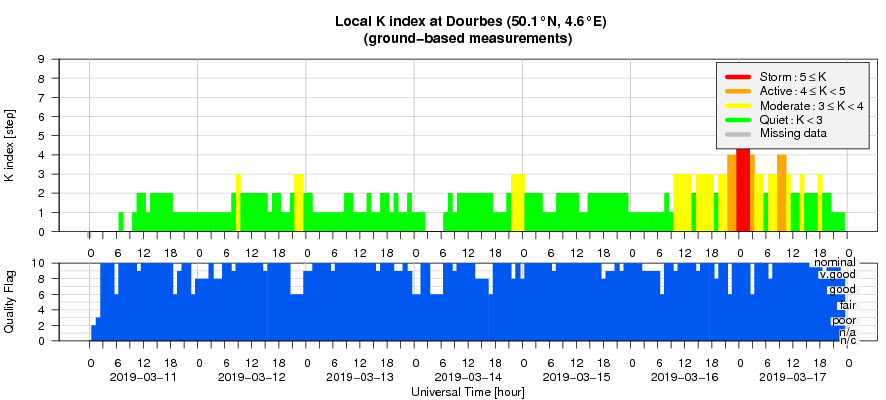- Table of Content
- 1.A new load of ...
- 2.PROBA2 Observa...
- 3.Review of sola...
- 4.The Internatio...
- 5.Review of geom...
- 6.Geomagnetic Ob...
- 7.The SIDC space...
- 8.Review of iono...
2. PROBA2 Observations (11 Mar 2019 - 17 Mar 2019)
3. Review of solar activity
4. The International Sunspot Number by SILSO
5. Review of geomagnetic activity
6. Geomagnetic Observations at Dourbes (11 Mar 2019 - 17 Mar 2019)
7. The SIDC space weather Briefing
8. Review of ionospheric activity (11 Mar 2019 - 17 Mar 2019)
A new load of space meteo operators
8 enthousiast meteo operators followed the STCE course to get transformed to a space weather operator. From March 14 onwards, they carry the title 'Trained and certified space weather operator'. The STCE space weather bulletin has no secrets anymore.
The 3 days course is a mixture of theory, exercises, silly games, visit to the STCE Space Weather forecast centre, the GNSS and Particle radiation centre, a talk with an expert in techniques for radio observations. No time to get bored.
The trainees will bring their new learned knowledge into their meteo room where an additional space meteo service is set up.
Wendy, Eelco, David, Fenneke, Jan, Joey, Martijn, René, well done!

PROBA2 Observations (11 Mar 2019 - 17 Mar 2019)
Solar Activity
Solar flare activity was very low during the week.
In order to view the activity of this week in more detail, we suggest to go to the following website from which all the daily (normal and difference) movies can be accessed: http://proba2.oma.be/ssa
This page also lists the recorded flaring events.
A weekly overview movie (SWAP week 468): http://proba2.oma.be/swap/data/mpg/movies/weekly_movies/weekly_movie_2019_03_11.mp4
Details about some of this week’s events, can be found further below.
If any of the linked movies are unavailable they can be found in the P2SC movie repository: http://proba2.oma.be/swap/data/mpg/movies/
Monday Mar 11
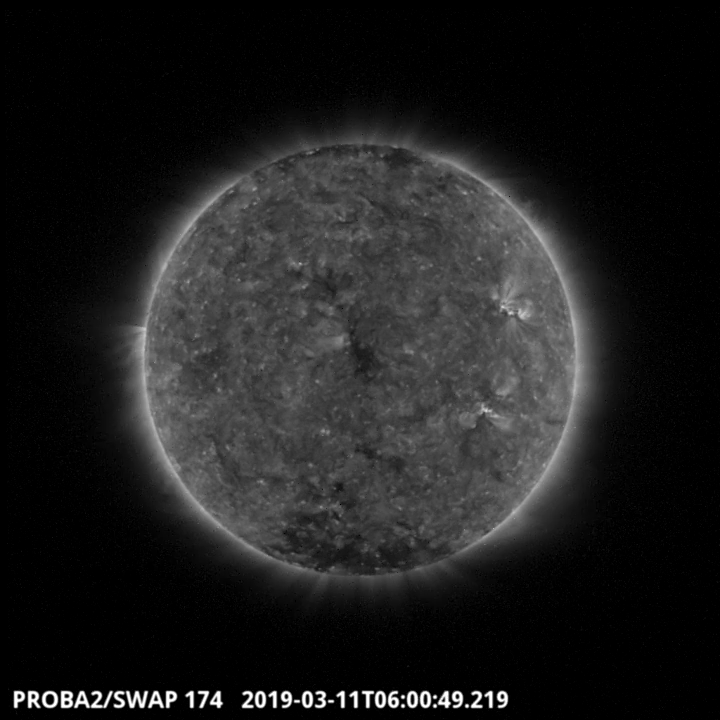
An extended coronal hole transited the solar meridian on 2019-Mar-11 around 06:00UT.
A movie of the events (SWAP movie): http://proba2.oma.be/swap/data/mpg/movies/20190311_swap_movie.mp4
Saturday Mar 16
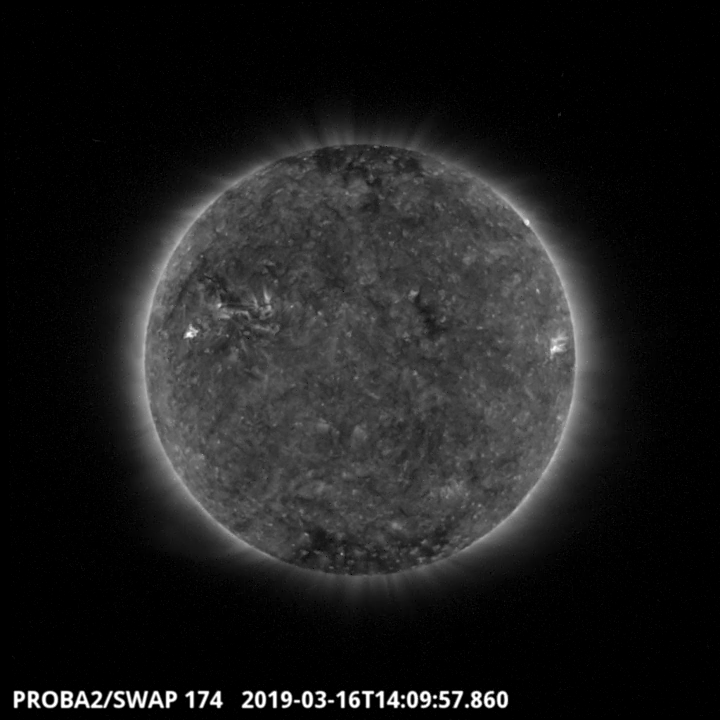
A single small flare was observed during this week, it was an A1.1 class flare which occurred on 2019-Mar-16 around 14:09 UT.
A movie of the event (SWAP movie): http://proba2.oma.be/swap/data/mpg/movies/20190316_swap_movie.mp4
Review of solar activity
Solar activity was very low with the X-ray flux below the B level. Catania group 9 (NOAA 2734) was decaying at the start of the week. A very short lived sunspot group (Catania 10) emerged and decayed in less than 24 hours. This happened in the middle of the week.
LASCO images showed a faint and slow Eastward CME in the UT morning of March 12. Although faint, its angular extent reached 180 degrees, i.e. a partial halo. The CME was better visible in STEREO A COR2 images where it moved straight to the West confirming that the CME was heading towards Earth. Its speed was estimated not to exceed the background solar wind speed.
An equatorial negative polarity coronal hole passed the central meridian overnight March 10/11. Another equatorial coronal hole, but with positive polarity crossed the central overnight March 14/15.
The solar proton flux levels were at background values.
The International Sunspot Number by SILSO
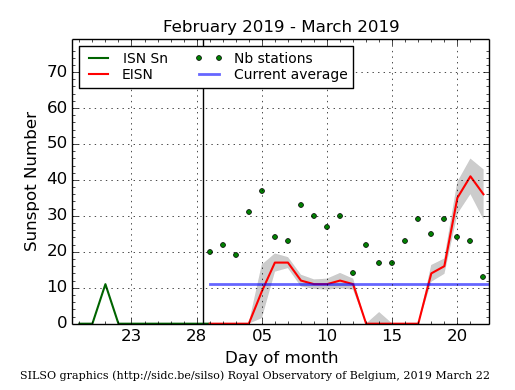
The daily Estimated International Sunspot Number (EISN, red curve with shaded error) derived by a simplified method from real-time data from the worldwide SILSO network. It extends the official Sunspot Number from the full processing of the preceding month (green line). The plot shows the last 30 days (about one solar rotation). The horizontal blue line shows the current monthly average, while the green dots give the number of stations included in the calculation of the EISN for each day.
Review of geomagnetic activity
The solar wind parameters were slightly enhanced.
On March 12, the March 8 CME arrived causing an increase in the solar wind speed to around 400 km/s and Bz reaching -8-9nT.
On March 15, 06:17UT, DSCOVR at the L1 point measured a slow forward shock followed by a minor increase of the solar wind speed to 400 km/s. The solar wind speed increased further to 450 km/s on March 16, afternoon. This period transitioned in what appears to be the passage of the March 12 CME on March 17 introducing a very prolonged period of negative Bz down to -6nT with a peak to -8nT.
The geomagnetic field responded to the solar wind. A minor geomagnetic storm after midnight March 16/17 was the result.
The SIDC space weather Briefing
The Space Weather Briefing presented by the forecaster on duty from March 11 to 17. It reflects in images and graphs what is written in the Solar and Geomagnetic Activity report.
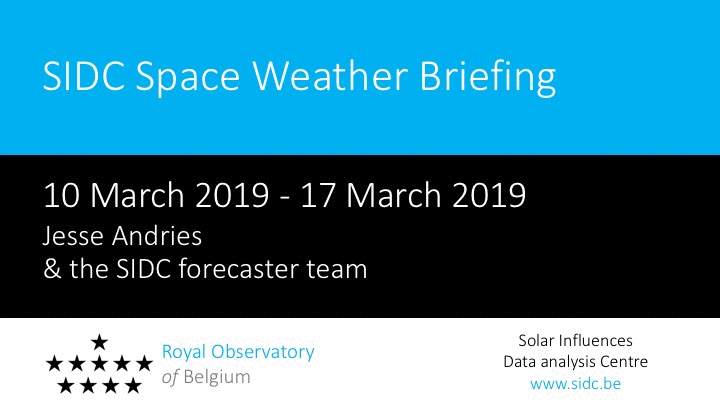
The pdf-version: http://www.stce.be/briefings/20190318_SWbriefing.pdf
The automatically running presentation: http://www.stce.be/briefings/20190318_SWbriefing.ppsm
Review of ionospheric activity (11 Mar 2019 - 17 Mar 2019)
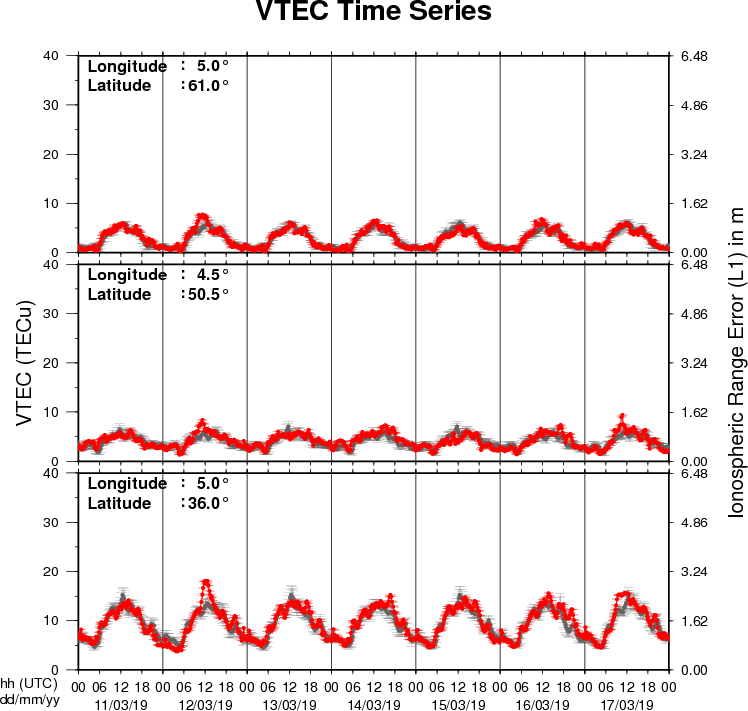
The figure shows the time evolution of the Vertical Total Electron Content (VTEC) (in red) during the last week at three locations:
a) in the northern part of Europe(N61°, 5°E)
b) above Brussels(N50.5°, 4.5°E)
c) in the southern part of Europe(N36°, 5°E)
This figure also shows (in grey) the normal ionospheric behaviour expected based on the median VTEC from the 15 previous days.
The VTEC is expressed in TECu (with TECu=10^16 electrons per square meter) and is directly related to the signal propagation delay due to the ionosphere (in figure: delay on GPS L1 frequency).
The Sun's radiation ionizes the Earth's upper atmosphere, the ionosphere, located from about 60km to 1000km above the Earth's surface.The ionization process in the ionosphere produces ions and free electrons. These electrons perturb the propagation of the GNSS (Global Navigation Satellite System) signals by inducing a so-called ionospheric delay.
See http://stce.be/newsletter/GNSS_final.pdf for some more explanations ; for detailed information, see http://gnss.be/ionosphere_tutorial.php
